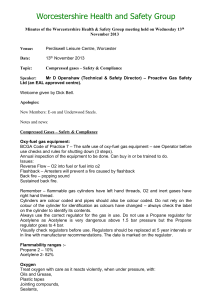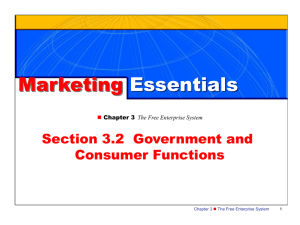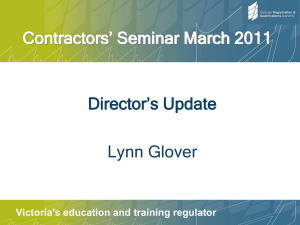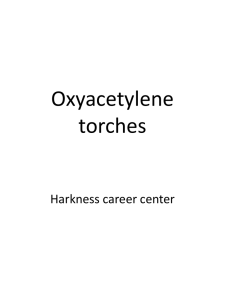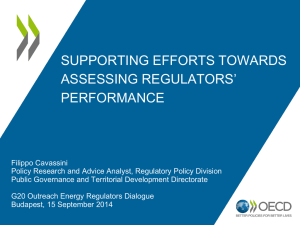Instructions for installing and using a gas regulator
advertisement
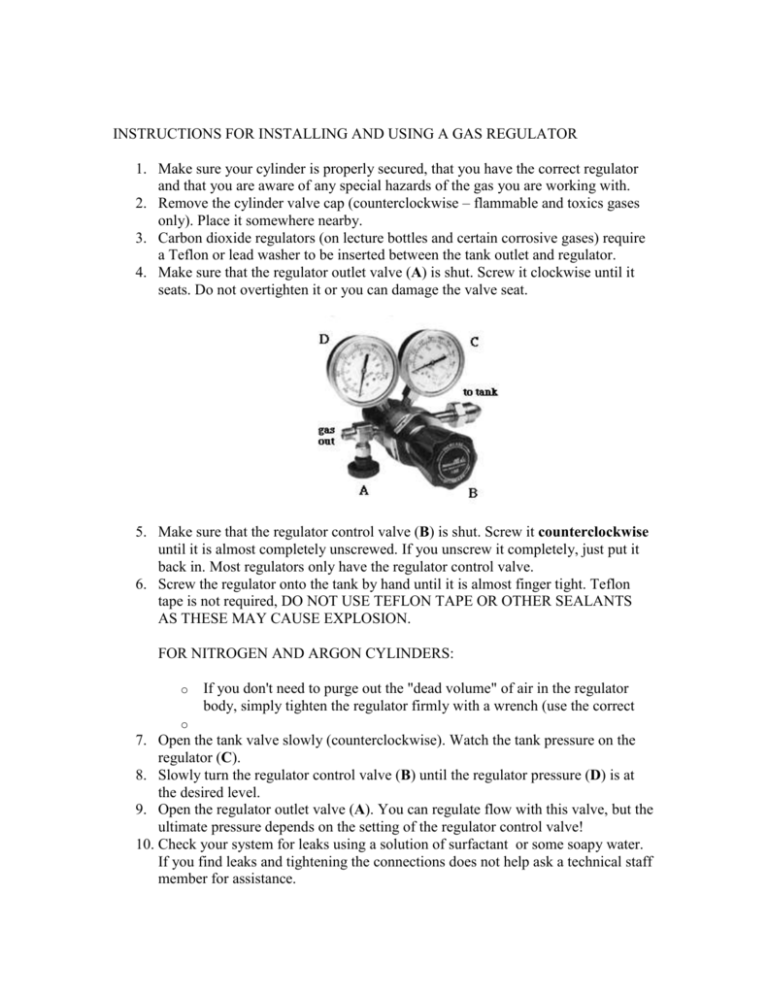
INSTRUCTIONS FOR INSTALLING AND USING A GAS REGULATOR 1. Make sure your cylinder is properly secured, that you have the correct regulator and that you are aware of any special hazards of the gas you are working with. 2. Remove the cylinder valve cap (counterclockwise – flammable and toxics gases only). Place it somewhere nearby. 3. Carbon dioxide regulators (on lecture bottles and certain corrosive gases) require a Teflon or lead washer to be inserted between the tank outlet and regulator. 4. Make sure that the regulator outlet valve (A) is shut. Screw it clockwise until it seats. Do not overtighten it or you can damage the valve seat. 5. Make sure that the regulator control valve (B) is shut. Screw it counterclockwise until it is almost completely unscrewed. If you unscrew it completely, just put it back in. Most regulators only have the regulator control valve. 6. Screw the regulator onto the tank by hand until it is almost finger tight. Teflon tape is not required, DO NOT USE TEFLON TAPE OR OTHER SEALANTS AS THESE MAY CAUSE EXPLOSION. FOR NITROGEN AND ARGON CYLINDERS: o If you don't need to purge out the "dead volume" of air in the regulator body, simply tighten the regulator firmly with a wrench (use the correct o 7. Open the tank valve slowly (counterclockwise). Watch the tank pressure on the regulator (C). 8. Slowly turn the regulator control valve (B) until the regulator pressure (D) is at the desired level. 9. Open the regulator outlet valve (A). You can regulate flow with this valve, but the ultimate pressure depends on the setting of the regulator control valve! 10. Check your system for leaks using a solution of surfactant or some soapy water. If you find leaks and tightening the connections does not help ask a technical staff member for assistance. Reminder: Do not use Teflon tape on Swagelock ferrule compression fittings. DISCONNECTING A REGULATOR 1. 2. 3. 4. 5. 6. Shut the tank valve on the gas cylinder. Slowly open the outlet valve (A) on the regulator. Watch the pressure gauges C and D drop to zero. Close regulator control valve (B) (anticlockwise). If you were using a corrosive gas, purge the system with a dry inert gas. Using a wrench (not pliers!) disconnect the regulator from the gas cylinder. Replace the protective cylinder cap immediately. 7. If your cylinder is empty, it must be properly labeled and then returned to gas storage area or distributor (in many cases, this is your school or company stockroom). Do not store empty gas cylinders in the laboratory. Reminder: Make sure the tank valve is closed whenever you are not dispensing gas through the regulator. Common Facts about Gas Regulations Equipment Two stage regulators control pressure better and don't really Single Stage cost much more. Single stage regulators tend to increase delivery pressure as cylinder pressure decreases (not much vs. Two Stage though). Most equipment manufacturers recommend and sell two stage regulators. Brass vs. Stainless Steel Brass regulators are acceptable for Ultra- high purity applications. Stainless steel bodies do not make regulators cleaner in regards to the gas flow. Stainless steel diaphragms are used in all high purity regulators regardless of their body material. Stainless Steel body regulators are needed for corrosive gases and harsh external environments. If the gauge shows 200 Regulators have springs inside that control the maximum lbs, why won't delivery pressure possible. The gauge does not dictate the maximum delivery pressure. it deliver to 200 lbs? Can I dial in 2 psi when the Not reliably. The regulator will actually fluctuate greatly if the range is too high. It will probably flow gas, but the pressure gauge goes all the way up will not be stable. to 200 psi? Will my regulator control gas Flow? Not well. Pressure regulators control pressure not flow. A flow valve will be needed to control flow. Why does my gas regulator Regulator hum indicates that the seat and stem dampers are hum worn or inoperative. It is also possible that you are using an sometimes? improperly ranged regulator. Can I use any old regulator for my application? Don't go into that drawer full of old regulators and assemble a regulator that fits. Gas cylinders have up to 30000 kPa of pressure. Accidentally putting a CGA fitting into a line regulator will result in a serious problem as cylinder pressure was increased from 20000 kPa. This could result in gas rupturing an old regulator. Does CO2 require a washer Yes, a small nylon or teflon washer is required for CGA 320 (CO2). If the washer is not present or severely deformed, the connection will leak. Do I need to use teflon tape for my cylinder to regulator connection? No, all cylinder connections are designed to connect without the use of teflon tape. Some connections use washers (320, 330,660) , but most connections use metal-to-metal contact to form a leak free connection. The use of teflon tape is not necessary, but it does not hurt anything. How tight should my cylinder connection be? When I turn the knob counterclockwise Tight enough not to leak. If the connection keeps leaking, check for damage to the face of the CGA fitting or debris in the cylinder valve connection. A washer could be missing as well (320, 330,660). Try not to use channel lock pliers to tighten your regulator - it will ruin the nut and most likely leak!!! Most laboratory regulators are designed to be non-self relieving. The regulator will not reduce it's delivery pressure unless the gas is flowing through the regulator. If the downstream segment of the system is static, the pressure will not drop unless you vent the system. However, the pressure (reduce pressure) on will increase if you dial in a higher pressure when the system is my regulator static. the delivery pressure does not change?
